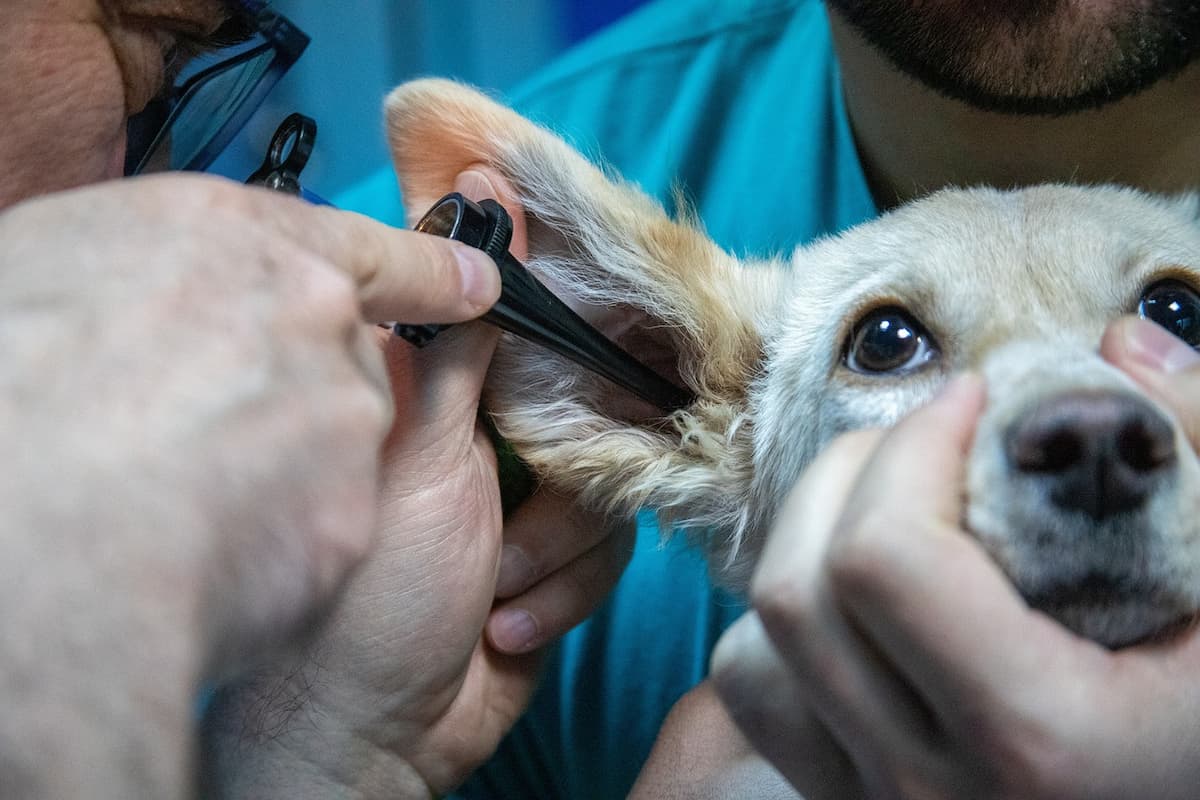Have you ever wondered why some dogs have their ears clipped?
It’s a trend that’s hard to ignore, especially when you see those adorable pups with their ears standing tall and proud.
Is it just a fashion statement or is there a deeper reason behind it?
Read on to find out.
Why Dogs Get Their Ears Clipped?
Have you ever wondered why some dogs have their ears clipped?
It’s a distinctive feature that is often seen in certain breeds, and you might be curious about the purpose behind it.
Here are some of those purposes.
1. Breed Standards and Aesthetics
For some dog breeds, clipped ears are a part of their breed standards.
Certain breeds, like Doberman Pinschers and Boxers, often have their ears clipped to achieve a more polished appearance.
It enhances their distinct look and helps them adhere to the desirable breed standards set by kennel clubs and breed organizations.
Clipped ears can give dogs a unique allure, transforming their appearance and making them easily recognizable.
While it may be a purely cosmetic procedure, it’s important to note that ear clipping should only be carried out by professional veterinarians to ensure the well-being of the dog.
2. Minimizing Injury and Ear Infections
Believe it or not, ear clipping can have practical benefits beyond aesthetics.
In certain dog breeds with floppy or long ears, such as Cocker Spaniels and Beagles, ear cropping can help prevent potential injuries and reduce the risk of ear infections.
By removing a portion of the ear, air circulation is improved, and debris and moisture are less likely to get trapped, which can lead to infections and discomfort for the dogs.
While regular cleaning and care can also address these issues, some owners and breeders opt for ear clipping as a preventive measure.
However, it’s essential to remember that consulting with a veterinarian is crucial to ensure the procedure is done safely and responsibly.
3. Cultural and Historical Significance
In certain cultures and historical contexts, ear cropping had different purposes.
Take the Doberman Pinscher, for example.
This breed was developed in Germany during the late 19th century as a guard dog.
The practice of clipping their ears was believed to enhance their hearing ability, making them more attuned to potential threats.
Similarly, other working or hunting breeds such as Boxers, Great Danes, and Cane Corsos also had their ears clipped to minimize the risk of ear injuries during their intense activities.
By giving dogs specific ear shapes, employers could also identify their purpose at a glance.
For example, hunting dogs might have a distinct ear clip to distinguish them from herding dogs or guard dogs.
While the motivations for ear clipping have evolved over time, it’s important to appreciate the cultural and historical significance behind this practice, even if it might not serve the same practical purpose in modern times.
The decision to clip a dog’s ears should always be made responsibly, considering the animal’s well-being above all else.
4. Symbol of Power and Prestige
In some cultures, certain breeds with clipped ears are considered symbols of power and prestige.
The cropped ears make these dogs appear more assertive and fierce.
Additionally, show dogs often have their ears clipped to adhere to breed standards and maintain a specific appearance in the show ring.
However, it’s important to note that ear clipping is not a requirement for all breeds and is a personal choice made by owners in consultation with veterinarians.
The Controversy Surrounding Ear Clipping
While some argue that ear clipping is purely a cosmetic choice, others raise important ethical considerations and animal welfare concerns.
Critics argue that this surgical procedure is unnecessary and harmful to dogs.
They contend that it infringes upon the animal’s natural appearance and can cause unnecessary pain and potential complications.
Additionally, opponents of ear clipping highlight the fact that dogs communicate with each other through their ears, and altering this essential means of communication may impact their social interactions and overall well-being.
As with any controversial topic, there are varying opinions and perspectives surrounding ear clipping.
It’s important for dog owners to inform themselves about both sides of the debate and carefully consider the ethical implications and potential health risks before making a decision.
Ultimately, the well-being and happiness of our furry friends should always be a top priority, and we must strive to strike a balance between aesthetic preferences and animal welfare concerns in our decision-making process.
Embracing Modern Approaches for Ear Health and Safety
There’s no denying that ear clipping has been a common practice for many dog owners over the years.
It’s often seen as a way to maintain ear health and prevent issues such as infections or ear mites.
However, as we embrace modern approaches to pet care, it’s crucial to question whether ear clipping is truly the best option for our furry friends.
Fortunately, there are several alternatives available that prioritize ear health and safety without resorting to this traditional method.
One effective alternative to ear clipping is regular cleaning and maintenance.
By establishing a routine of gentle ear cleaning, you can help prevent issues before they occur.
Using a vet-recommended ear cleaning solution and a soft cloth, carefully wipe the outer part of your dog’s ears, removing any excess wax or debris.
It’s essential to be gentle and avoid inserting anything into the ear canal, as this can cause damage.
Regular cleaning not only keeps your dog’s ears clean but also allows you to detect any unusual signs or symptoms early on.
Another alternative worth considering is natural remedies for ear health.
There are numerous products available that harness the power of natural ingredients to promote ear health and prevent infections.
These remedies often come in the form of gentle, soothing drops that can be applied directly to your dog’s ears.
Look for products containing ingredients like witch hazel, aloe vera, or coconut oil, as these can provide relief and reduce inflammation.
Additionally, maintaining a healthy diet and providing proper hydration can also contribute to overall ear health in your furry friend.
Embracing modern approaches for ear health and safety is all about finding alternatives that prioritize your dog’s well-being.
Opting for regular cleaning and maintenance, as well as utilizing natural remedies, can effectively promote ear health without the need for ear clipping.
Remember, always consult with a veterinarian for personalized advice and to address any concerns regarding your dog’s ear health.
Together, we can ensure our furry friends receive the best care possible for their precious ears.
FAQ
Q: So, why do dogs get their ears clipped in the first place?
A: Well, dog ear clipping, also known as ear cropping, is a surgical procedure in which a portion of a dog’s ears is removed.
This practice has a long history and can be traced back to different reasons across time and various dog breeds.
Q: Can you tell us about the historical reasons for ear cropping?
A: Sure thing!
Back in the day, ear cropping was primarily performed for practical purposes.
Certain breeds, like Boxers and Dobermans, used to work as guard or hunting dogs, and cropping their ears served as a protective measure.
By removing a part of the ear, it reduced the likelihood of the dog’s ears being damaged during intense activities.
Q: Does ear cropping serve any other purposes?
A: Yes, it does.
Besides the practical reasons, there are also aesthetic motivations behind ear cropping.
Some dog breeds, like the Great Dane or Miniature Pinscher, are more often associated with having cropped ears as part of their breed standards.
Ear cropping is seen as a way to enhance their physical appearance, giving them a distinctive and regal look.
Q: Is ear cropping still a popular practice today?
A: While ear cropping was more common in the past, its popularity has decreased significantly in recent years.
Many countries and regions have banned the practice, considering it unnecessary and potentially detrimental to a dog’s well-being.
Today, it is mainly performed for breed-related standards or if there is a medical necessity due to ear infections or injuries.
Q: What are some arguments against ear cropping?
A: Critics of ear cropping argue that it is an unnecessary surgery that causes pain and discomfort to dogs.
They believe that altering a dog’s natural appearance solely for aesthetic purposes is unfair to the animal.
Many argue that responsible breeding and proper care can mitigate the need for cropping.
Q: Are there any downsides or risks associated with ear cropping?
A: Like any surgical procedure, there are risks involved with ear cropping.
Dogs may experience pain, bleeding, or infections during the recovery period.
If not performed by a skilled veterinarian, the results can be unsatisfactory or lead to complications.
Moreover, the emotional toll on these animals can be problematic, as they might struggle to effectively communicate through ear movements.
Q: What’s the stance of veterinary organizations on ear cropping?
A: Several veterinary associations and organizations have voiced their concerns about ear cropping.
These groups generally discourage the practice unless there is a genuine medical reason.
They argue that maintaining a dog’s natural appearance, combined with responsible breeding, helps ensure the health and welfare of the animal.
Q: Can dog owners opt for alternatives to ear cropping?
A: Absolutely!
Nowadays, there are various alternatives available for dog owners who wish to achieve a similar look without subjecting their pets to ear cropping.
These include adhesive prosthetics or even artistic cropping of dog ear photos to create the appearance in images, promoting dog welfare and avoiding unnecessary surgeries.
Q: So, what’s the bottom line on ear cropping?
A: Ultimately, ear cropping is an ancient tradition that has evolved over time.
While it might have served practical purposes in the past, the general perception has shifted towards considering it a cosmetic procedure that potentially compromises a dog’s well-being.
With alternatives readily available, many people believe in embracing a more natural approach and letting a dog’s ears be as nature intended.
Final Thoughts
From ancient traditions to practical purposes, it’s clear that there isn’t a one-size-fits-all answer.
We must remember that context is key, and what may seem strange or even cruel to some actually holds deep-rooted significance for others.
Whether it’s about distinguishing working dogs from the crowd or protecting those adorable floppy ears from infection, the reasons behind ear clipping have spanned centuries.
But as times change and our understanding of animal welfare evolves, we can’t deny that there are ethical considerations to take into account.
Ultimately, it’s up to us – as responsible dog owners and guardians – to carefully weigh the pros and cons of ear clipping.
Before making any decisions, we should consult with experts, veterinarians, and animal advocacy organizations who can provide guidance and ensure the well-being of our furry friends.
As our bond with dogs continues to grow stronger, it’s essential to remember that they too have their own preferences and needs, often expressed through their body language.
By keeping an open mind, respecting their natural appearance, and striving to provide a safe and loving environment, we can honor and cherish the remarkable companionship that dogs bring into our lives.














